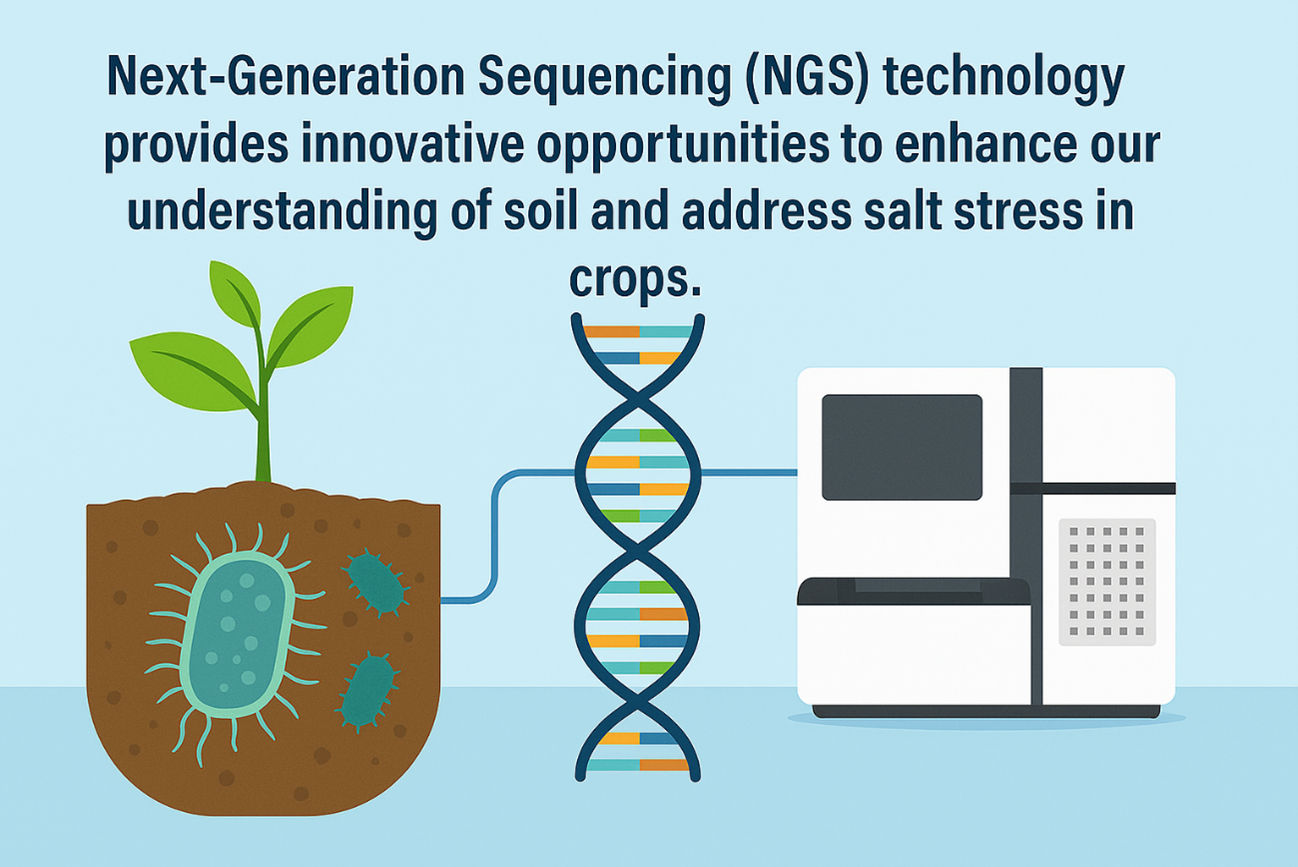
Invisible allies against salinity: microbiota and sequencing for resilient agriculture
In a situation where soil salinity poses a significant threat to global agricultural productivity, scientific research is increasingly focusing on the vital role of soil microorganisms.
According to the Food and Agriculture Organization (FAO), soil salinity is a major challenge for agriculture worldwide, impacting over 20% of arable land. This issue arises from the accumulation of soluble salts, such as sodium, magnesium, and calcium, in the soil, which hinders plants’ ability to absorb water and essential nutrients necessary for their growth. Additionally, suboptimal soil management practices— including excessive irrigation without adequate control, deforestation, and urbanization— exacerbate this challenge. Research indicates that improper irrigation practices can result in salt accumulation due to water evaporation, consequently diminishing crop productivity.
As climate change affects rainfall patterns and increases global temperatures, the increase in salinity is threatening food security and affecting key crops in multiple regions. This situation of overexploitation and mismanagement of water resources not only exacerbates salt stress but also leads to soil degradation, a well-documented issue that diminishes the soil’s capacity for regeneration and directly affects biodiversity and ecosystems.

The rise in salinity is one of the most pressing challenge in modern agriculture. The scientific community is proactively tackling this issue by developing innovative solutions. In this regard, Next-Generation Sequencing (NGS) has emerged as a valuable technology. Recent advancements in NGS have allowed researchers to analyze plant genomes with great precision, which has been facilitaterd the identification of key genes linked to salt stress resistance. The integration of NGS with genetic studies has advanced crop improvement through genetic engineering, aiming to transfer salt tolerance traits from halophytes -plants that thrive in high salinity environments- to more susceptible crops. This strategy provides a promising avenue for cultivating more resilient crops, ultimately enhancing agricultural productivity in salt-affected soils and contributing to future food security.
Similarly, Next-Generation Sequencing (NGS) has facilitated substantial advancements in our understanding of soil microbiota, the diverse community of microorganisms (including bacteria, fungi, actinobacteria, and others) that inhabit the soil and are essential for its health and plant development. Metagenomic and bioinformatic studies are offering clearer insights into the microbial diversity found in soils, particularly those impacted by salinity, and how this microbiota can affect plant tolerance to challenging conditions. A well-balanced soil enriched with microbial biodiversity enhances plant resilience under various stressors, thereby improving agricultural productivity. Consequently, understanding and effectively managing soil microbiota -especially in saline environments- emerges as a crucial strategy for fostering more sustainable and efficient agricultural practices.

The halophilic microbiota found in saline soils plays a vital role in assisting plants in managing salt stress. Utilizing Next-Generation Sequencing (NGS), we can identify and comprehensively characterize the microorganisms present in these environments, particularly those adapted to high salinity. NGS facilitates the mapping of microbial diversity, enabling the identification of specific bacteria and fungi that promote plant growth, as well as assessing their metabolic capabilities. Certain microorganisms, including particular fungi and bacteria, can produce bioactive compounds that serve as protective barriers for plant roots, helping to mitigate the adverse impacts of salinity. This molecular approach presents new opportunities for developing microbial inoculants derived from these beneficial microorganisms, which can be directly applied to saline soils to enhance agricultural productivity in a more sustainable and resilient manner. By adopting these technologies, we can also reduce dependence on chemical products, which, while sometimes effective, may pose risks to ecosystems and human health.
“NGS facilitates the mapping of microbial diversity, enabling the identification of specific bacteria and fungi that promote plant growth, as well as assessing their metabolic capabilities.”
This approach -integrating the study of soil microbiota with Next-Generation Sequencing (NGS) technology– offers a more efficient strategy for addressing salinity while promoting sustainable agricultural practices. It supports long-term soil health and minimizes environmental impact. In this context, soil microbiota emerges as a pivotal ally in confronting one of the most significant agricultural challenges of the 21st century.
From our laboratory at CARTIF, we have the technological capabilities and the necessary expertise to study and characterize both soil microbiota and its interaction with plants under saline stress conditions. Through the use of next-generation sequencing (NGS) tools, bioinformatics analyses, and molecular assays, we can identify beneficial microorganisms that promote soil health and crop resilience, thereby contributing to the development of more sustainable agricultural practices adapted to today’s environmental challenges.
1 Global status of salt-affected soils, Foro Internacional del Suelo y el Agua. 2024 Bangkok. Organización de las Naciones Unidas para la Alimentación y la Agricultura (FAO).
2 Singh AK, Pal P, Sahoo UK, Sharma L, Pandey B, Prakash A, Sarangi PK, Prus P, Pașcalău R, Imbrea F. Enhancing Crop Resilience: The Role of Plant Genetics, Transcription Factors, and Next-Generation Sequencing in Addressing Salt Stress. Int J Mol Sci. 2024 Nov 22;25(23):12537. doi: 10.3390/ijms252312537.
3 Frąc M, Hannula SE, Bełka M, Jędryczka M. Fungal Biodiversity and Their Role in Soil Health. Front Microbiol. 2018 Apr 13;9:707. doi: 10.3389/fmicb.2018.00707.
4 Mishra A, Singh L, Singh D. Unboxing the black box-one step forward to understand the soil microbiome: A systematic review. Microb Ecol. 2023 Feb;85(2):669-683. doi: 10.1007/s00248-022-01962-5.
5 Pérez-Inocencio J, Iturriaga G, Aguirre-Mancilla CL, Vásquez-Murrieta MS, Lastiri-Hernández MA, Álvarez-Bernal D. Reduction in Salt Stress Due to the Action of Halophilic Bacteria That Promote Plant Growth in Solanum lycopersicum. Microorganisms. 2023; 11(11):2625. doi:10.3390/microorganisms11112625.
6 Adomako MO, Roiloa S, Yu FH. Potential Roles of Soil Microorganisms in Regulating the Effect of Soil Nutrient Heterogeneity on Plant Performance. Microorganisms. 2022 Dec 3;10(12):2399. doi: 10.3390/microorganisms10122399.